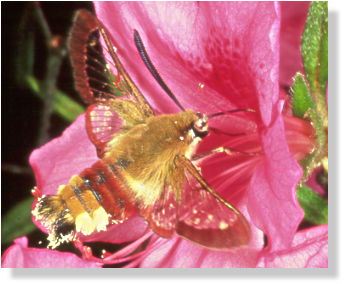 |
Finally we
introduce a species that sometimes is taken for a bumble-bee or
"tiny humming-bird": the broad-bordered
bee hawk-moth
(Hemaris fuciformis).
Bee hawk-moths form a group of their own amongst the hawk-moths, represented by two species in central and northern Europe, which are the one just mentioned and the humming-bird hawk-moth. Both are active during the day, which is why they are the ones commonly perceived. Often humans are enthused when they come across a bee hawk-moth. The species shown is not rare. You may encounter a specimen at the flower pots of your balcony or terrace. Josť took this picture on his terrace. |